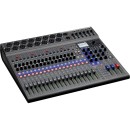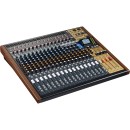TASCAM Model 24 vs Zoom LiveTrak L-20: A Detailed Comparison
The TASCAM Model 24 is a versatile device that combines the functionality of a digital mixer, recorder, and USB audio interface. It features a 22-channel mixer with 16 high-grade TASCAM mic preamps, which ensure high-quality audio capture for a wide range of applications. This model is designed to offer an intuitive workflow with its familiar analog-style layout, making it accessible for both novice and experienced users. The Model 24 also includes a built-in 24-track recorder, which allows users to record directly to an SD card, providing a seamless and reliable recording experience. Additionally, its USB audio interface function supports 24-bit/48kHz resolution, making it suitable for professional-level audio production.
In contrast, the Zoom LiveTrak L-20 is a powerful digital mixer and multitrack recorder that caters to more demanding live and studio environments. With 20 discrete channels and 22-track simultaneous recording capabilities, the L-20 is designed for larger productions. It also features 16 mono channels with high-performance preamps, offering excellent sound clarity. One of its standout features is the ability to create up to six customizable monitor mixes, allowing individual performers to have personalized mixes during live performances. Additionally, the L-20's USB audio interface supports up to 24-bit/96kHz audio resolution, providing high-quality audio streaming and recording.
Both the TASCAM Model 24 and the Zoom LiveTrak L-20 offer impressive features but cater to slightly different needs. The TASCAM Model 24 is ideal for users who prefer an analog-style interface and need a reliable, all-in-one solution for recording, mixing, and interfacing with computers. On the other hand, the Zoom LiveTrak L-20 is more suited for users who require advanced mixing capabilities and higher resolution audio recording, particularly for live settings or larger studio sessions. Each device has its strengths, making them suitable for different types of audio projects and user preferences.
In the following sections, we will provide a detailed comparison of the TASCAM Model 24 and the Zoom LiveTrak L-20. This comprehensive analysis will cover their specifications, as well as highlight the advantages and disadvantages of each product, providing you with all the information needed to make an informed choice.
Specifications, Advantages, and Disadvantages
| User Rating Based on Analysis of Reviews | |
|---|---|
|
Show More |
| Pros: | |
|---|---|
|
|
| Cons: | |
|---|---|
|
|
| Find Best Price | Find Best Price |
| General |
|---|
| Signal Processing | |
|---|---|
| EQ Parameters | |
| High: ±15 dB at 10 kHz (Shelving) Mid: ±15 dB at 100 Hz to 8 kHz (Semi-Parametric) Low: ±15 dB at 100 Hz (Shelving) |
Mono Channels: High: ±15 dB at 12 kHz (Shelving) Mid: ±15 dB at 100 Hz to 8 kHz, 0.55 Q (Semi-Parametric) Low: ±15 dB at 80 Hz (Shelving) Stereo Channels: High: ±15 dB at 12 kHz (Shelving) Mid: ±15 dB at 600 Hz, 0.55 Q (Notch/Peak) Low: ±15 dB at 80 Hz (Shelving) Graphic EQ: ±15 dB at 8 kHz ±15 dB at 4 kHz ±15 dB at 2 kHz ±15 dB at 1 kHz ±15 dB at 500 Hz ±15 dB at 250 Hz ±15 dB at 125 Hz |
| Built-In Effects | |
| 20x Effect (Type Unspecified) |
7x Reverb 2x Mono Delay 1x Stereo Delay Chorus Flanger 2x Delay+Reverb 2x Chorus+Reverb |
The TASCAM Model 24 features a gain/trim range of -10 dB to +40 dB for channels 1 to 12 and -20 dB to +30 dB for channels 13 to 20, offering a versatile mic input gain of up to 50 dB. It includes a high-pass filter set at 100 Hz, 18 dB/Octave, and a comprehensive EQ system for both mono and stereo channels, with parameters allowing for adjustments of ±15 dB across various frequencies. Additionally, the Model 24 comes equipped with a built-in effects section featuring 7x Reverb, 2x Mono Delay, 1x Stereo Delay, Chorus, Flanger, and various combinations of delay and reverb effects.Show More
In contrast, the Zoom LiveTrak L-20 offers a simpler 3-Band EQ with parameters that allow ±15 dB adjustments at 10 kHz for high, and 100 Hz to 8 kHz for mid, along with a low setting at 100 Hz. The L-20 incorporates dynamic processing with a compressor on mono channels, providing additional control over audio dynamics. It features a solo/mute function per input channel, enhancing its usability for live performances. The built-in effects section of the L-20 boasts 20 unspecified effect types, which provides a broad range of sound enhancement options.
Ultimately, while both the TASCAM Model 24 and Zoom LiveTrak L-20 serve as digital mixers and multitrack recorders, the TASCAM offers a more intricate EQ system and a wider variety of built-in effects. On the other hand, the Zoom excels in its dynamic processing capabilities and user-friendly solo/mute functions. Each mixer caters to different user needs, whether it be for detailed sound shaping or straightforward live mixing and recording.
| Connectivity | |
|---|---|
| Wireless | |
| Bluetooth *Via Optional Adapter |
Bluetooth |
The TASCAM Model 24 serves as a versatile digital mixer, recorder, and USB audio interface with a robust array of analog audio I/O options. It features 20x 1/4" TRS Balanced Line Inputs and 16x XLR 3-Pin Balanced Mic Inputs, allowing for extensive connectivity for live performances or studio settings. Additionally, it includes various unbalanced inputs like 1x 1/8" TRS and 1x RCA Coaxial, making it adaptable for multiple audio sources. The device also offers a range of outputs, including 2x XLR 3-Pin Balanced Outputs and 2x 1/4" TRS Subgroup/Bus Outputs, ensuring a comprehensive setup for sound routing.Show More
On the other hand, the Zoom LiveTrak L-20 is designed specifically for live performances and multitrack recording. While it excels in its multitracking capabilities, it lacks the extensive analog I/O options found in the TASCAM Model 24. The L-20 features a streamlined approach with essential inputs for live sound but does not provide detailed specifications regarding its input and output options, which could limit connectivity compared to TASCAM's offering.
In terms of phantom power, the TASCAM Model 24 provides 48 V phantom power, making it suitable for condenser microphones. In contrast, the Zoom LiveTrak L-20 does not specify phantom power capabilities, which may affect its compatibility with certain microphones. Furthermore, connectivity options highlight a difference, with the TASCAM boasting a USB-B port for Class-Compliant connections and Bluetooth capability, while the Zoom requires an optional adapter for Bluetooth functionality.
Ultimately, while both mixers have their strengths, the TASCAM Model 24 is more versatile in terms of connectivity and audio routing options, making it suitable for both studio and live applications. The Zoom LiveTrak L-20, however, focuses more on multitrack recording for live situations, catering specifically to performers looking for a hands-on recording solution.
| Performance | |
|---|---|
| Headphone Output Power | |
| 10 mW per Channel into 60 Ohms (Max) | 80 mW per Channel into 32 Ohms |
The TASCAM Model 24 features a maximum input level of +8 dBV for unbalanced stereo inputs and +22 dBu for balanced line inputs, making it versatile for various audio sources. The mic inputs have a maximum input level of +10 dBu, which is suitable for capturing vocals and instruments with clarity. In comparison, the Zoom LiveTrak L-20 does not specify its maximum input levels in the provided specifications, but it is designed to accommodate multiple input sources as well.Show More
When it comes to output levels, the TASCAM Model 24 boasts a maximum output level of +22 dBu for XLR main outputs and +16 dBu for monitor, FX, subgroup, and control room outputs. This ensures a strong signal can be sent to external devices or speakers. On the other hand, the Zoom LiveTrak L-20 does not provide detailed output level specifications in the comparison, which may be a consideration for users needing consistent output levels.
The headphone output power is another significant aspect where the TASCAM Model 24 stands out, providing 80 mW per channel into 32 Ohms, allowing for a loud and clear monitoring experience. In contrast, the Zoom LiveTrak L-20 offers a lower headphone output power of 10 mW per channel into 60 Ohms, which may limit the volume levels achievable during monitoring.
Finally, regarding impedance, the TASCAM Model 24 has a variety of input and output impedances, such as 1.8 Kilohms for mic inputs and 100 Ohms for XLR main outputs, ensuring compatibility with a wide range of audio equipment. The impedance specifications for the Zoom LiveTrak L-20 are not provided, which could affect its integration with specific audio gear.
| Compatibility |
|---|
| Power |
|---|
| Packaging Info | |
|---|---|
| Package Weight | |
| 11.4 lb | 28.7 lb |
| Box Dimensions (LxWxH) | |
| 21.2 x 18 x 5.8" | 25.25 x 25 x 8.75" |
The TASCAM Model 24 is a robust digital mixer, recorder, and USB audio interface, boasting a package weight of 28.7 lb. This weight reflects its sturdy construction and extensive feature set, making it suitable for various recording environments. The box dimensions of 25.25 x 25 x 8.75 inches indicate a larger footprint, which may require more space in a studio setup.Show More
In contrast, the Zoom LiveTrak L-20 is significantly lighter, with a package weight of just 11.4 lb. This lower weight enhances its portability, making it an appealing choice for mobile recording setups or musicians on the go. Additionally, its more compact box dimensions of 21.2 x 18 x 5.8 inches allow for easier storage and transport, catering to users who prioritize flexibility and convenience.
Overall, while the TASCAM Model 24 offers a heavier, more robust option with a larger size suitable for stationary use, the Zoom LiveTrak L-20 provides a lighter, more portable solution ideal for those needing mobility without sacrificing functionality.
| Customer Images | |
|---|---|
| Videos | |
|---|---|
|
|
|







